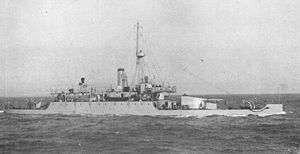BL 6 inch naval guns Mk XIII – XVIII
| Type | Naval gun |
|---|---|
| Place of origin |
|
| Service history | |
| In service | 1914 - 1940s |
| Wars | World War I World War II |
| Production history | |
| Designer |
Mk XIII, XVII, XVIII : EOC Mk XIV, XV, XVI : Vickers |
| Variants | Mk XIII, XIV, XV, XVI, XVII, XVIII[1] |
| Specifications | |
| Barrel length | 300 inches (7.620 m) bore (50 cal) |
|
| |
| Shell | 100 pounds (45.36 kg) |
| Calibre | 6 inches (152.4 mm) |
| Muzzle velocity |
Mk XIII : 2,770 feet per second (840 m/s) Mk XIV & XV : 2,900 feet per second (880 m/s) Mk XVI : 3,000 feet per second (910 m/s) Mk XVII : 2,905 feet per second (885 m/s) Mk XVIII : 2,874 feet per second (876 m/s) |
This article covers a number of fairly similar British-built 6-inch 50-calibre naval guns that found their way into British service in World War I. Their specifications and performance differed from standard Royal Navy 6-inch guns but in British service they fired standard service 100-pound projectiles.
6-inch Mark XIII gun in Royal Navy service

When World War I began, Armstrong-Whitworth were completing the battleship Sultan Osman I for the Ottoman Empire, originally begun as Rio de Janeiro for Brazil. Its secondary armament consisted of 20 of their 6-inch 50 calibre guns, which were similar in design and characteristics to the British naval service Mk XI gun and used the same ammunition. The battleship was completed as HMS Agincourt and served in the Royal Navy in World War I, with its guns designated BL 6 inch Mk XIII.
After the decommissioning of Agincourt in 1921 her 6-inch guns were used for coastal defence, and in 1939 the British gunboats Aphis and Ladybird each had their 2 6-inch Mk VII guns replaced with 2 MK XIII guns, in which capacity they served in World War II.
6-inch Mark XIV and XV guns in Royal Navy service

When World War I began, the Royal Navy had just taken possession of 3 river monitors originally built by Vickers for Brazil but which Brazil could not pay for. These were each equipped with 2 Vickers 6-inch 50-calibre guns in a twin turret, and became the Humber-class monitors. These guns were very similar to the British service Mk XI gun, and in UK service they were designated BL 6 inch Mk XIV (right-hand gun, with breech opening to the right) and BL 6 inch Mk XV (left-hand gun, with breech opening to the left). The guns of HMS Severn and HMS Mersey wore out early in the war from continuous use bombarding the Belgian coast and in East Africa, and were replaced by standard 6-inch Mk VII guns, while HMS Humber continued to use various refurbished Mk XIV and XV guns throughout the war for coastal bombardment.
6-inch Mark XVI gun in Royal Navy service
At the beginning of World War I the British Government forcibly acquired the battleship Reshadieh which Vickers had just completed for the Ottoman Government. The ship entered service with the Royal Navy as HMS Erin together with its armament which while of similar calibre to British service ordnance was of differing specification. Erin had sixteen 6-inch 50 calibre guns made by Vickers, with a muzzle velocity of 3,000 feet per second (910 m/s)[2] which was considerably greater than existing standard Royal Navy 6-inch guns. These guns were designated 6-inch BL Mark XVI in British service. Some were redeployed in World War II for coast defence.
6-inch Mark XVII gun in Royal Navy service

When World War I began, Armstrong-Whitworth were building the battleships Almirante Latorre and Almirante Cochrane for Chile. They were acquired by the British government and completed as the battleship HMS Canada and the aircraft carrier HMS Eagle. The secondary armament for each supplied by Armstrongs were 12 6-inch 50-calibre guns, which were designated 6-inch BL Mk XVII in British service. These guns were used from 1915 on HMS Canada until she was sold to Chile in 1920 as originally intended. HMS Eagle was completed after World War I and retained by the Royal Navy, with these guns retained as her primary defensive armament.
6-inch Mark XVIII gun in Royal Navy service
When World War I began, Armstrong-Whitworth were building the coast defence ships Nidaros and Bjørgvin for Norway. They were acquired by the British government and completed as the monitors HMS Gorgon and HMS Glatton respectively. Their secondary armament as designed was 4 15-cm guns designed by Armstrongs. In Royal Navy service these guns were relined to the standard British 6-inch calibre and they were adapted to fire standard 6-inch 100-pound shells.
See also
Notes
- ↑ Mk XIII = Mark 13, Mk XIV = Mark 14, Mk XV = Mark 15, Mk XVI = Mark 16, Mk XVII = Mark 17, Mk XVIII = Mark 18. Britain used Roman numerals to denote Marks (models) of ordnance until after World War II. Hence these were the thirteenth through to eighteenth models of BL 6-inch guns in British service.
- ↑ Tony DiGiulian, British 6"/50 (15.2 cm) BL Mark XVI
References
- Tony DiGiulian, British 6"/50 (15.2 cm) BL Mark XIII
- Tony DiGiulian, Britain 6"/50 (15.2 cm) BL Mark XIV 6"/50 (15.2 cm) BL Mark XV
- Tony DiGiulian, British 6"/50 (15.2 cm) BL Mark XVII 6"/50 (15.2 cm) BL Mark XXI
- Tony DiGiulian, British 6"/49 (15.2 cm) BL Mark XVIII
External links
| Wikimedia Commons has media related to BL 6 inch naval guns Mk XIII - XVIII. |